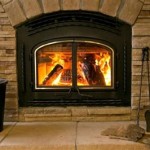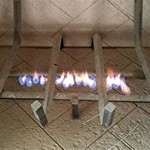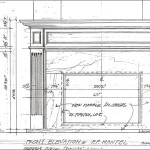Old Wood Burning Fireplace Inserts With Blower: A Retrofit Solution for Enhanced Heating Efficiency
Wood-burning fireplaces have long been appreciated for their aesthetic appeal and the cozy ambiance they provide. However, traditional open fireplaces are notoriously inefficient, losing a significant amount of heat up the chimney. One effective solution to improve the heating performance of an existing fireplace is to install a wood-burning fireplace insert equipped with a blower. These inserts are designed to fit into the existing firebox, transforming it into a more efficient heating appliance. While newer, EPA-certified models are available, many homeowners are interested in understanding the specifics of older models and their capabilities.
An old wood-burning fireplace insert with a blower represents a potential upgrade for homeowners seeking to enhance the heating capacity of their existing masonry fireplace. These inserts function by creating a closed combustion system, which drastically reduces heat loss. The blower unit, integrated into the insert, actively circulates heated air into the room, resulting in a more even and consistent temperature distribution. This system contrasts sharply with open fireplaces, where most of the heat radiates directly outwards, leaving other parts of the room cooler and allowing significant heat to escape up the chimney.
Understanding the Mechanics of Old Fireplace Inserts
Old wood-burning fireplace inserts, though often lacking the advanced technology of newer models, operate on relatively simple principles. These inserts are typically constructed from cast iron or steel, materials chosen for their ability to withstand high temperatures and efficiently radiate heat. The firebox of the insert is sealed, except for an air inlet and an exhaust outlet, allowing for controlled combustion of the wood. The air inlet allows the user to adjust the air supply to the fire, controlling the burning rate and heat output. The exhaust outlet is connected to a flue liner that runs up the chimney, safely venting the combustion gases to the outside.
The blower, also known as a fan, is a crucial component in these inserts. It is usually located at the rear or underneath the firebox. As the fire burns, the insert's metal casing heats up. The blower then draws cool air from the room, passes it across the heated surfaces of the firebox, and forces the warmed air back into the room. This forced-air convection process significantly increases the amount of heat distributed throughout the room compared to the radiant heat provided by an open fireplace.
Operationally, the wood is loaded into the firebox, ignited, and the air inlet is adjusted to achieve the desired burn rate. The blower is typically controlled by a switch, allowing the homeowner to regulate the airflow and, consequently, the heat output. Some older models may feature adjustable thermostats, enabling the blower to automatically turn on or off depending on the temperature of the insert.
Advantages and Considerations of Using Older Models
While newer EPA-certified inserts offer greater efficiency and cleaner burning, older models can still provide a viable heating solution, particularly if they are well-maintained and properly installed. One of the primary advantages is the potential cost savings. Older inserts are often available at a lower price point than their modern counterparts. However, it's crucial to factor in potential refurbishing costs, such as replacing worn parts, cleaning the unit, and ensuring proper ventilation.
Another consideration is the aesthetic appeal. Many older inserts have a classic or vintage design that may complement the style of older homes. The simpler mechanics can also make them easier to understand and repair for individuals with some mechanical aptitude. Nonetheless, it is crucial to prioritize safety when using an older insert.
Older models may not meet current emissions standards. This means they may produce more smoke and particulate matter than newer, EPA-certified inserts. As a result, the suitability of an older insert depends on local regulations and the homeowner's environmental concerns. Appropriate flue lining is a must to ensure safety, preventing creosote buildup which can cause chimney fires.
Safety and Maintenance for Old Wood Burning Fireplace Inserts
Safety is of paramount importance when operating any wood-burning appliance, especially older models. Regular inspections of the insert and the chimney are essential. A qualified chimney sweep should inspect and clean the chimney at least once a year to remove creosote and other debris. Creosote buildup is a significant fire hazard and can also reduce the efficiency of the insert.
The insert itself should also be regularly inspected for signs of damage or wear. Check for cracks in the firebox, leaks in the flue connections, and proper operation of the blower. Any damaged components should be repaired or replaced promptly. It is recommended to use a carbon monoxide detector in the home to provide an early warning system for potential carbon monoxide leaks, which can be deadly.
Proper wood selection is also important. Burn only seasoned, dry hardwood to maximize efficiency and minimize smoke production. Avoid burning treated wood, painted wood, or other materials that can release harmful chemicals into the air. Following these safety guidelines and adhering to a regular maintenance schedule will help ensure the safe and efficient operation of an old wood-burning fireplace insert with a blower, providing years of reliable heating.

Wood Fireplace Inserts With Blowers Upgrade Your

Ventis Hei240 Wood Burning Insert Rockford Chimney

Wood Stove With Mailbox Blower Housing Fireplace Inserts

Best Wood Burning Fireplace Insert With Blower Forestry Reviews

Wood Burning Fireplace Insert With Blower Blowers Inserts

Wood Burning Fireplaces Inserts Full Service Chimney

T25i Timberwolf Wood Fireplace Insert Hearth Stove Patio

Wood Inserts Fireplace And Stove The Hearth Doctor Inc

Wood Burning Inserts For Your Fireplace Stove Insert

Vanguard Converts Your Old Wood Burning Fireplace Into An Efficient Vent Free
Related Posts








